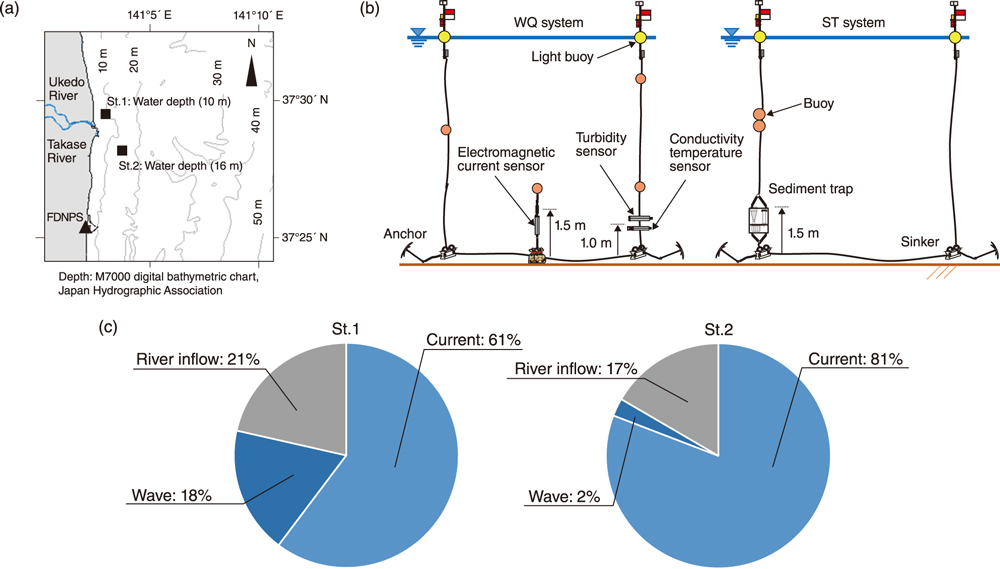Radioactivity Dynamics in River System
(2024)
QHow extent does radiocesium flowing in from rivers affect the coastal environment?
AThe results of the survey indicated that the particles containing 137Cs in the turbid region (high turbidity layer) formed by sediment from the seafloor and river inflows are dominated by resuspension, and that the influence of newly supplied 137Cs from river inflows is small.
After the accident at TEPCO’s Fukushima Daiichi Nuclear Power Station (FDNPS), “Dynamic radioactive cesium (137Cs) studies” in the sea area have been conducted to address concerns about the transfer of radioactive materials to marine products. Even now, 12 years after the accident, a small amount of 137Cs is being transported from land to sea via rivers. In particular, in the coastal region, there exists a turbid area (high-turbidity layer) near the seabed. This layer is formed by the resuspension sediment and river flow.
The 137Cs present in such a highly turbid layer may affect small organisms living on the seabed and the benthic fish that prey on these organisms. Hence, there is a need to elucidate the supply mechanism. The high-turbidity layer is easily transported by waves and currents and is thought to play an important role in radioactive material transport. Understanding the relationship between the high-turbidity layer in coastal areas and the amount and timing of 137Cs inflow from rivers is important for predicting future impacts on benthic fish.
In this study, we conducted a survey in a coastal area to understand the actual situation of the effect of 137Cs in the high-turbidity layer on the river.

Fig.1 Study area, method and result
(a) Observation points (St.1 and St.2) are indicated by black squares.
(b) Observations were conducted from 2017 to 2018; the water quality (WQ) system performed continuous measurement for approximately one year, while the sediment trap (ST) system was installed for 55 days to measure the amount of sinking particles.
(c) Resuspension of seabed sediments was the primary origin of the particles in the high-turbidity layer.
The observation site was set at the Ukedo River estuary, which has a large basin area around the FDNPS, as shown in Fig.1(a). We installed two mooring systems, namely, a water quality system (WQ system) and a sediment trap system (ST system), as shown in Fig.1(b). The ST system incorporated a ST to measure the amount of particles forming the high-turbidity layer (sinking particles). The WQ system is equipped with an instrument to measure the variation in turbidity and current in the high-turbidity layer. The index of particle migration (shear stress) was calculated from the current and publicly available wave data obtained from the WQ system.
The variation in high-turbidity layer (variation of sinking particles) can be estimated from three factors: current, waves (resuspension of seabed sediment), and river inflow (sediment and other suspended matter from rivers). The percentage contribution of the three factors to total turbidity was calculated by multiple regression analysis.
Using the percentage of each factor to distinguish the sinking particles, the percentage of resuspension averaged 79% for St. 1 and 83% for St. 2 (Fig.1(c)). Thus, it is shown that the particles containing 137Cs in the high-turbidity layer are predominantly attributed to resuspension, and the influence of newly supplied 137Cs by river inflow is small. In the future, we plan to calculate the offshore transport in the high-turbidity layer to contribute to basic data for predicting the transfer of 137Cs to benthic fish.
Related articles
- Do radiation does will increase using bathing beach?
- How is the concentration of radioactive cesium in seawater and marine sediment changing?
- Does forest type (deciduous broad-leaf forests or cedar forests) affect the dynamics of radioactive Cs?
- How much does additional internal dose exposure would be if we assume highest concentration during the fire event was exposed? How harmful for the health?
